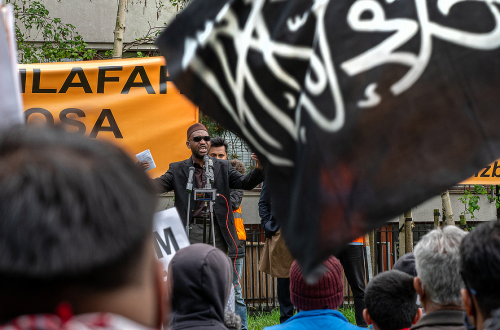Having previously hesitated, the BBC this week chose to screen Ilan Ziv‘s film Searching for Exile: Truth or Myth?, which focuses on the idea of Jewish exile after AD 70. Ziv’s film starts ambitiously:
01:24 “What has been considered as fact for centuries, is now being challenged by archaeological evidence unearthed across Israel.”
The evidence is confined to the village of Tzippori, a town in Galilee:
01:35 “Here, in the ancient town of Sepphoris, just 70 miles from Jerusalem, evidence points – not to a people driven into exile – but on the contrary, to a population that not only survived, but flourished.”
Ziv highlights how Tzippori’s Jews did not provide any resistance to the Romans. He took this fact from Josephus, rather than from any new archaeological evidence.
With sinister strings playing in the background, Ziv’s robotic-sounding narrator asks:
23:55 “Why is it that exile has been historically perceived as a fact, and the destruction of Jerusalem as the evidence?”
Ziv uses the community of Tzippora Jews in the Galilee to argue that there was no Jewish exile, as Jews were still living in the region after AD 70. The Bar Kochba revolt of 135 is also held up as evidence against the ‘myth of exile’.
Yet no-one would say that all the Jews disappeared from Jerusalem in AD 70. Of course there has been a continual Jewish presence in Israel.
Crucially, the loss of temple life and Jerusalem as a nexus and focal point for the Jewish world was in itself an exile. The Jews from around the empire had been used to coming to Jerusalem for festivals, for sacrifices, for trade and for teaching. The temple’s destruction, and the accompanying Roman massacres on a horrific scale, were a hammer blow to the heart of Jewish life at the time.
Indeed, the centrality of Jerusalem and the Temple were vital to the identity of the country. Without it, the Jewish nation essentially was without religious identity as well as geographical sovereignty. That was the importance of exile: both physical exile of some who were actually enslaved, and the exile of others from a land with the Temple.
To fail to understand this is completely to fail to understand Judaism or Jewish history, on a very basic level.
Before Ziv has really tied up his arguments, he suddenly brings in the Palestinian Arabs who fled their towns in 1948, to argue that they might be the descendants of the Tzippori Jews from the first century.
The sudden mention of Palestinians seems forced. It also seems that Ziv is using an argument to support Palestinian nationalism – blood descent from Jews – that he would never use to support Israeli nationalism, as he would see it as racist.
When pressed on the blood issue in a BBC debate (15:38), Ziv concedes there is no evidence for his theory about Palestinian descent.
In the same debate, Ziv is gently defeated by Professor Joan Taylor of King’s College London (07:57), who gently points out that the internal migration of Jews from Jerusalem to Galilee is still an exile as Jews lost the Temple and Jerusalem – and that in any case, there was a huge Jewish exile following the Bar Kochba revolt.
Ziv replies by saying:
“I think the difference between us is really the perception of exile which means, the exile the way we were brought up, okay?
Ziv has no answer to Taylor’s superior knowledge of history, and so is reduced to talking about ‘perception’.
Not good enough for the BBC, I don’t think.
—-
Addendum:
Here is the transcript of how Ziv is defeated by Professor Taylor.
Taylor: Well, I think we’ve got to distinguish between two revolts here. There was the first revolt, normally called the Great Revolt, and then the second revolt, known as the Bar Kochba Revolt in 132-135. As a result of the Bar Kochba revolt, Dio Cassius tells us that 985 Judaden villages were totally razed to the ground, 580,000 fighting men were killed, plus countless numbers of women and children, others, and Judaea was rendered a wilderness. And after that I think we do have to talk about an exile, so it’s not a case of saying, “oh in 70 yes there were still archaeological sites that you can see where Jews were continuing to live in Judaea”, which we can see up unto 132-135. But after 135 really not, and archaeology does confirm that from 135 Jews in Judaea but they do go to Galilee, they go to Seppheros –
Ziv: Exactly, that’s the whole point, which means there was an internal migration from one damaged region to the Galilee. So… the issue. .. and there is a migration to the Galilee, so we’re not gonna… debate about numbers because it doesn’t lead us far, but the question of the exile in a sense that we grew up on, that the Jews left the country, okay, and are coming back in the 19th century, that is the way the myth has been presented.
Taylor: Going to Galilee is a kind of exile. To not live in Judaea, to not live in Jerusalem, to not be allowed to even see Jerusalem from afar, by Hadrian’s decree, that is an exile.
Ziv: I think the difference between us is really the perception of exile which means, the exile the way we were brought up, okay? Historically, even in Christian theology, is the expulsion of Jews from their country, which has been emptied out, and until the 19th century Jews started to trickle back and today we have the state of Israel. So we cannot disassociate that perception, okay? The historical evidence that you cite, which means the migration to the Galilee, the tremendous catastrophe of losing the temple, okay? The change in Jewish religion because of that, which is the Mishnah, all of that is… but – that’s not in the popular mind…
He might as well be saying: “History is fun, but I’m an Israeli anti-Zionist and I want you to take me seriously!”
Update: Zachary adds:
“…Tzippori’s Jews did not provide any resistance to the Romans…”
But Josephus tells us they did, only long before 70 CE, in 4 BCE. They rebelled against Rome’s client king, Herod the Great, and Varus suppressed them directly with the Roman army, killing and enslaving thousands, if not most Sepphoreans (Ant. Jud. XVII 10.5-9 (271-287): Varus “took Sepphoris, and made its inhabitants slaves, and burnt the city”! (cf. Bel. Jud. II 5.1 (56-69)).
Sepphoris was among the first Jewish towns to revolt against the Romans, and was in large part ethnically cleansed as a result!
Herod Antipas refounded the city with the eponym ‘Anticratoris’ with, it is likely, a very different population make up: Herod made it into the fortress-capital of the Galilee, precisely to ensure no future rebellions! (Ant. Jud. XVII 2.1; cf. Bel. Jud. II 18.2)
Unsurprisingly, the stuffing having been kicked from Tzippori, and likely many of her inhabitants, including the flower of her youth, to the next world too, her response to the revolt of 70 was rather subdued.
By Josephus’ time Sepphoris was quite atypical from the rest of the Galilee: “those of Sepphoris [] were the only people to whom [Josephus] gave leave to build their own walls [] because he perceived they were rich and wealthy, and ready to go to war, without standing in need of any injunctions for that purpose” (Bel. Jud. II 20.6): since 6 CE Sepphoris had been rebuilt and repopulated as, to all intents and purposes, a Herodian Jewish colony to serve Herodian and, by extension, imperial Roman interests.
This is about the worst example Ziv could have chosen.
Sepphoris revolted against Josephus’ command in 68 CE, yet he retook it, he says, without warfare (Bel. Jud. 21.8; 21.10). Whereupon the leaders of the revolt were sent to Jerusalem, where other Galileans’ wanted to punish them (Bel. Jud. II 21.7).
[…]
Act. 5.37 actually mentions Judah the Galilean, principal in the Fourth Philosophy:
‘After him, Judas the Galilean appeared in the days of the census and led a band of people in revolt. He too was killed, and all his followers were scattered.’
That started in Sepphoris!


